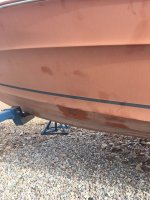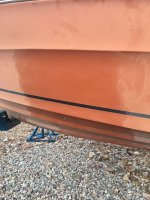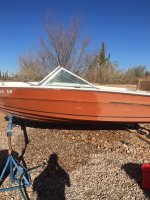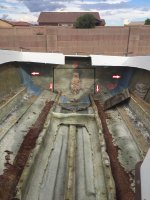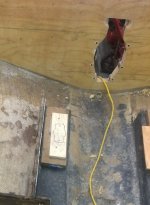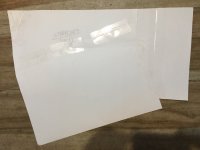Luposian
Petty Officer 2nd Class
- Joined
- Aug 15, 2015
- Messages
- 108
Ok, I'm basically finished restoring my trailer, so back to working on the boat!
I'm looking at repainting my boat. The hull (everything at/below the water line (which I assume is where the black tape/vinyl is) is the main priority, because it has to go back onto the trailer before March (wife is hosting a church "party" at out house, in March, so don't want kids playing around a boat on stands). Have several pictures. Not sure exactly what I'm dealing with. Is it horribly oxidized gelcoat? Ablative paint? How can I tell the difference? It's chalky and comes off on my fingers. But... both oxidized gelcoat and ablative paint will do that.
1st pic: Before cleaning
2nd pic: first scrub (with water, dish soap and a scrubby sponge)
3rd pic: rubbed away chalky swirls left behind after first scrub (even after blasting it with a garden hose nozzle), with my fingers and a towel.
4th pic: larger section more thoroughly cleaned.
Am I seeing what I should be seeing (after a thorough cleaning and wipe down)? As long as it's as clean as I can get it, is it good enough? Do I need to do any prep sanding to help the paint adhere? I'm going with water-based bottom paint, to limit fumes. I want white. The upper sides will be a shade of blue. We'd like to go with something similar to our truck, but... not sure we can get that close a match. Not that our truck will ever haul our boat (my wife/son won't do it and I don't drive), but the color scheme seems nice. Wife likes the idea. Trying to get her "into" (interested/involved with) the boat at all, as it was nearly impossible to get her to agree to having me own one... even for just $250!
I'm looking at repainting my boat. The hull (everything at/below the water line (which I assume is where the black tape/vinyl is) is the main priority, because it has to go back onto the trailer before March (wife is hosting a church "party" at out house, in March, so don't want kids playing around a boat on stands). Have several pictures. Not sure exactly what I'm dealing with. Is it horribly oxidized gelcoat? Ablative paint? How can I tell the difference? It's chalky and comes off on my fingers. But... both oxidized gelcoat and ablative paint will do that.
1st pic: Before cleaning
2nd pic: first scrub (with water, dish soap and a scrubby sponge)
3rd pic: rubbed away chalky swirls left behind after first scrub (even after blasting it with a garden hose nozzle), with my fingers and a towel.
4th pic: larger section more thoroughly cleaned.
Am I seeing what I should be seeing (after a thorough cleaning and wipe down)? As long as it's as clean as I can get it, is it good enough? Do I need to do any prep sanding to help the paint adhere? I'm going with water-based bottom paint, to limit fumes. I want white. The upper sides will be a shade of blue. We'd like to go with something similar to our truck, but... not sure we can get that close a match. Not that our truck will ever haul our boat (my wife/son won't do it and I don't drive), but the color scheme seems nice. Wife likes the idea. Trying to get her "into" (interested/involved with) the boat at all, as it was nearly impossible to get her to agree to having me own one... even for just $250!




















